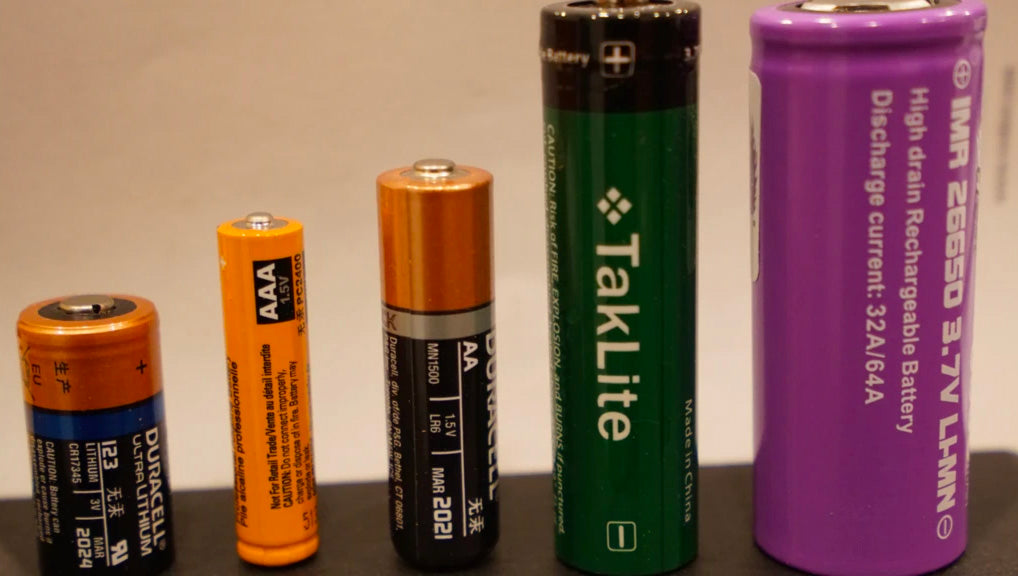
CR123A vs 18650: Which Battery To Choose?
In the flashlight world, there are two variations of Lithium batteries that manufacturers use: Lithium-Metal and Lithium-Ion. In this article, we'll explain some of the differences between the two batteries and discuss which battery is right for you.
CR123A (Primary Non-Rechargeable Lithium Metal)
CR123A batteries, also known as primary lithium-metal batteries, are currently the most popular form of lithium batteries. While some will be quick to argue otherwise, the reality is that primary lithium-metal batteries can be purchased in virtually any corner-store whereas rechargeable lithium-ion batteries can not.
There is just one small problem: they are not rechargeable.
Once drained, they must be disposed of and replaced. Averaging around $1.20~ per battery when bought in bulk, and around $4~ per when bought in stores, it's easy to see how quickly the costs can add up. Compounded by the fact that most modern tactical flashlights require two or even three CR123A batteries for operation, the absurdity of these batteries is easy to see.
So - why do people still use CR123A batteries?
CR123A batteries can be useful because they have an incredibly wide operating temperature range -- meaning they can be used in extremely cold or extremely hot environments with less issues. Furthermore, CR123A batteries are considered by many to be a "survivor's ultimate tool" due to their lengthy shelf life. CR123A batteries can be safely stockpiled for periods of 10 years while still retaining a significant charge. A lithium-ion battery wouldn't even last half that.
This tolerance to the elements makes CR123A batteries popular in mission critical situations where failure can mean the difference between life and death. This is usually why most pistol-mounted flashlights are based on a CR123 battery configuration.
Pros:
- Can retain charge for up to 10 years
- Wide operating temperature range (-40C - 85C)
- Made in USA Brands Available
Cons:
- Not rechargeable
- Not practical for high output flashlights
- Very expensive
18650 Lithium-Ion (Secondary Rechargeable Lithium-Ion)
While lithium-ion batteries have been used for years in laptop battery packs and other appliances, they have only recently gained popularity in the flashlight world. These batteries, which also happen to be the exact same batteries used in Tesla's new electric cars, are fully rechargeable and offer a much better value for consumers. They tend to be a little less tolerant to extreme environments but the difference is largely negligible for the average consumer.
Fun Fact: One 3400mAh lithium-ion cell averages around $12 and can last upwards of 500 recharge cycles. Two CR123A batteries would cost anywhere from $3-$5, only offer a maximum capacity of 3100mAh, and can't be recharged!
Pros:
- Fully rechargeable
- Cheap to buy
- Can support much higher currents
Cons:
- Only manufactured overseas*
- Poor long term shelf life
- Slightly more complex (risk of overcharging/overdischarging)
*A common argument domestic CR123A manufacturers make is that lithium-ion cells are all manufactured overseas. While this is true, the irony is that the same company (Panasonic) that manufactures their CR123A batteries is also the same company that manufactures the rechargeable lithium-ion cells they are against! The only difference is that CR123A batteries are manufactured in Panasonic's Georgia facility whereas lithium-ion batteries are manufactured in Panasonic's Japan facility.
The Bottom Line:
It is pretty clear that rechargeable lithium-ion 18650 cells are a much better value for the average consumer. Lasting an average of two years with 500~ recharge cycles, they are the ultimate battery for use with flashlights. There is no reason to spend upwards of $5 on replacement batteries multiple times per week when you can simply buy a rechargeable lithium-ion battery.
However, if you're anything like me, you always keep a modest stock of CR123A batteries anyways. The incredible shelf life is difficult to argue with and they can certainly prove to be useful in a critical situation. Just make sure you refer to your flashlight's operating manual prior to use.
See our selection of Lithium-Ion Batteries
